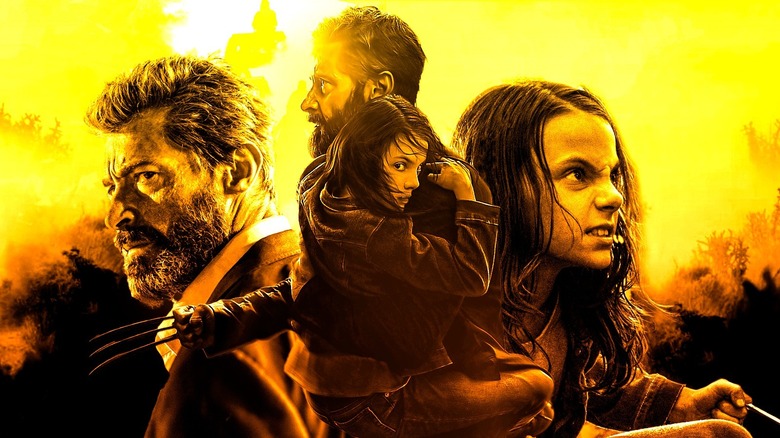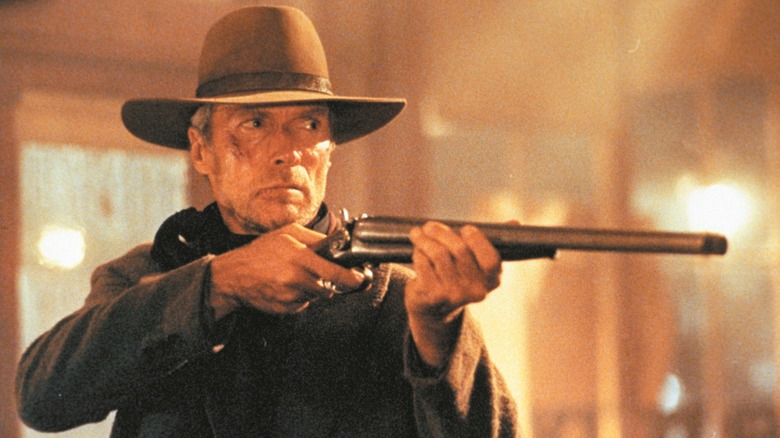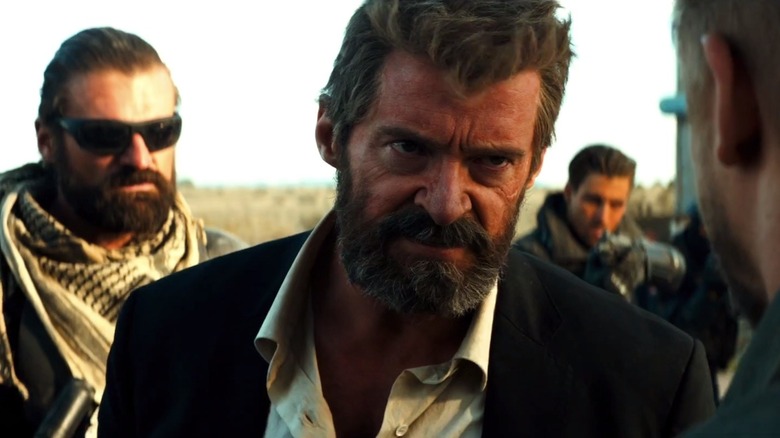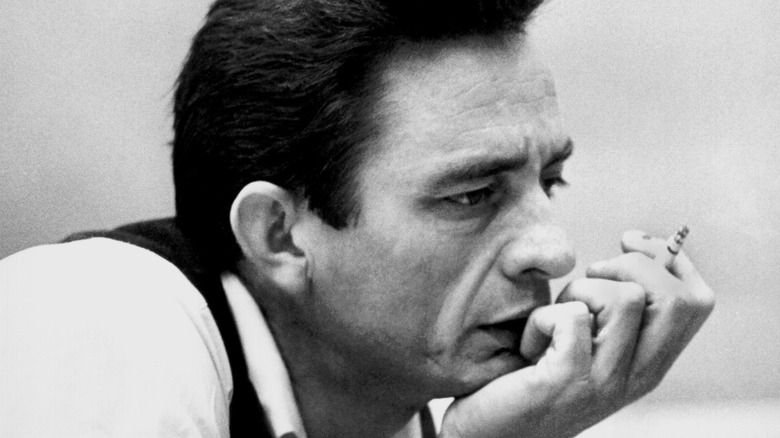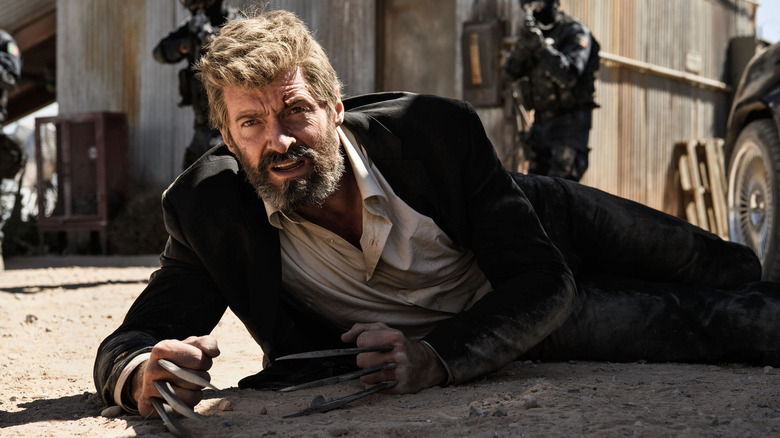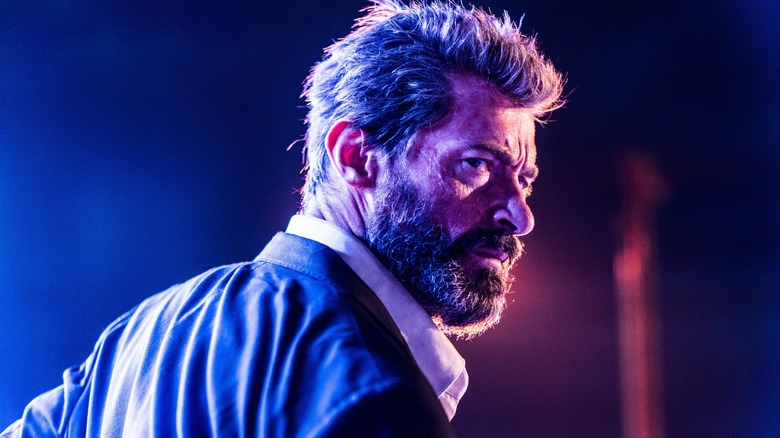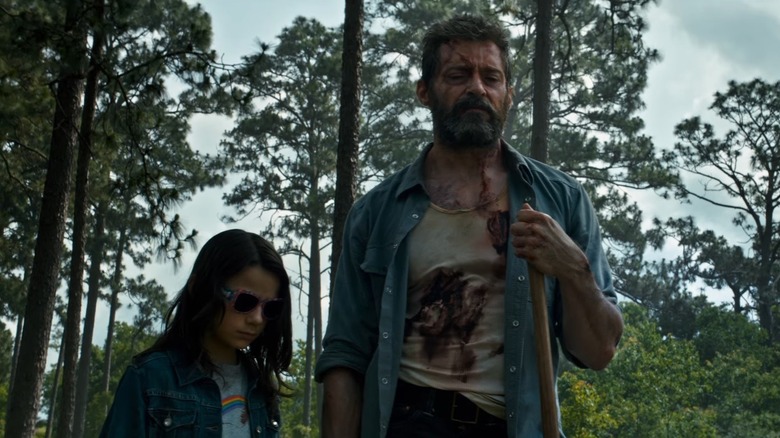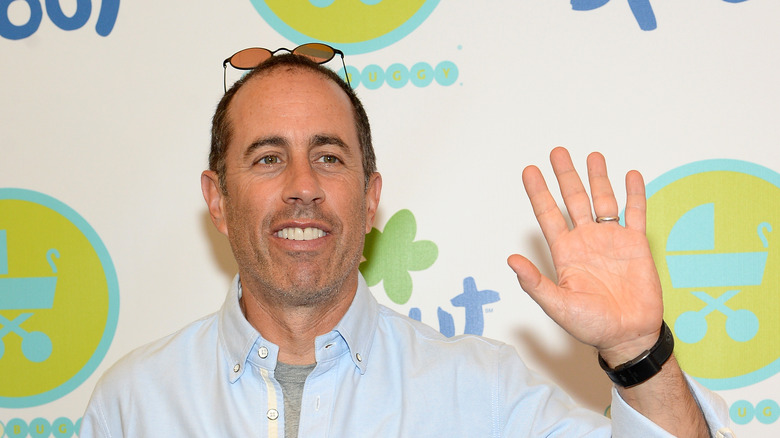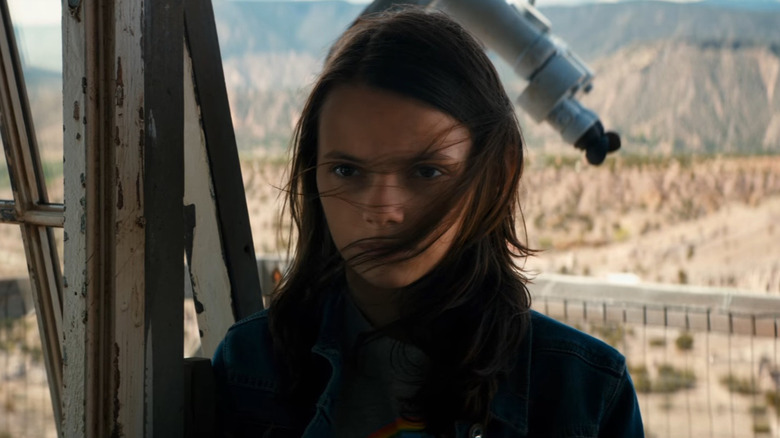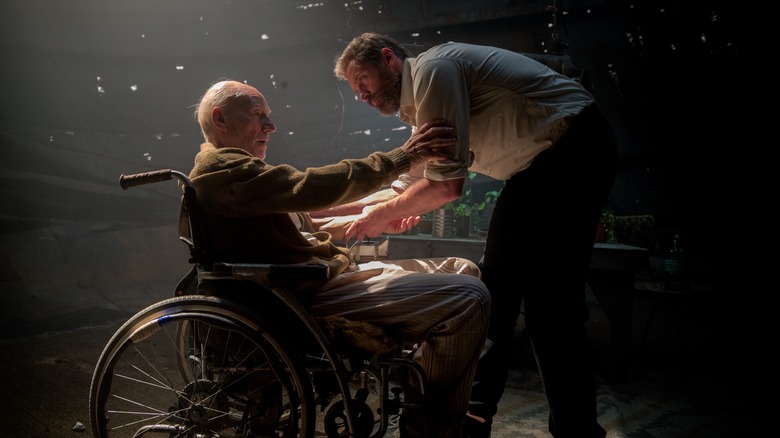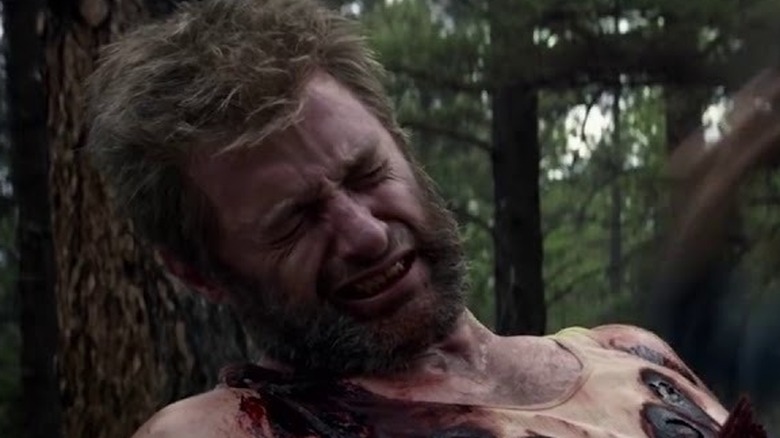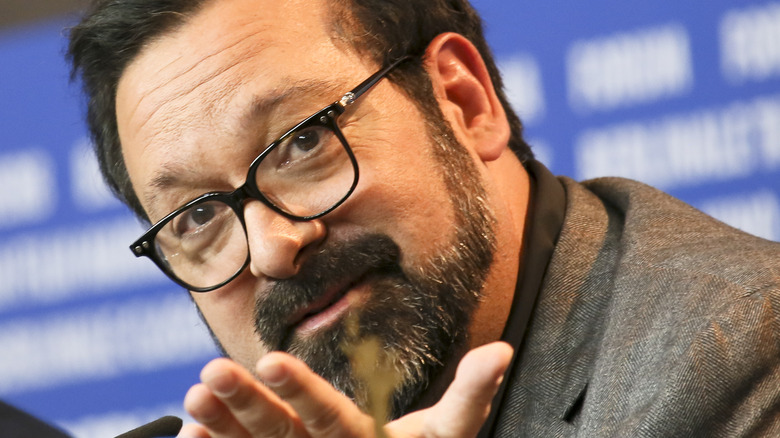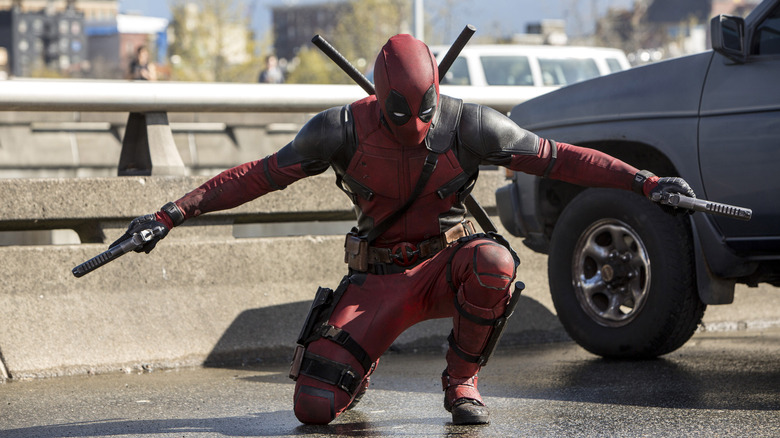12 Ferocious Logan Facts To Sink Your Teeth Into
Everything ends. Even moody mutants with claws made of adamantium and the ability to survive a thousand deaths. Yet when he first snarled his way onto the screen like a whirlwind of sullen and paranoid fury in "X-Men," we knew that when the bell eventually tolled for Hugh Jackman's Wolverine, he would not go gentle into that good night. James Mangold's "Logan" is a fitting swan song to the charismatic loner with an abrasive attitude and a heart of gold. It's a fine example of what happens when you take the Western and superhero genres and mix them together for something more significant than the sum of their parts.
Seeing our superheroes old, diminished, riddled with regret, and working as chauffeurs is not a common occurrence, particularly when they're renowned for their steely-eyed resilience and powers of accelerated healing. From the opening scene, "Logan" is all about defying conventions. It's easily one of the best superhero movies ever made because it ignores outlandish plots, flashy powers, and even flashier costumes to focus on themes that are universal to us all. "Logan" is about accepting the past and coming to terms with who you are. It's about staying true to the ideals that matter. Best of all, "Logan" reminds us what a mean, lean and unstoppable force of nature Wolverine is when his blood is up and he's in full berserker mode. Mess with the wolf and you get the claws.
Here are some facts about the film we saved from the shredder.
Hugh Jackman wanted to make a film like Unforgiven or The Wrestler
Superhero films are all well and good, but there are only so many times you can conquer unbeatable odds, win the day, and make a sarcastic quip before walking off into the sunset. Without change, there is no meaning, and after a run of eight films, Hugh Jackman was no doubt getting itchy feet and thinking about hanging up his claws. After all, you can have too much of a good thing and there's nothing quite like bowing out when you're on top. Not only did Jackman want "Logan" to be his last rodeo as Wolverine, he told Digital Spy that he and director James Mangold wanted the film to exist independently outside of the X-Men universe. "Not only is it different in terms of timeline and tone, it's a slightly different universe. It's actually a different paradigm," explained Jackman.
With their intention clear to make this Wolverine's grand finale, the studio gave Jackman and Mangold the freedom to fulfill their vision. Jackman explained he wanted to pull something different out of the box in the mold of the "Unforgiven" or "The Wrestler." Both movies revolve around a protagonist whose glory days have been left rotting in a ditch somewhere, with characters drinking deep in the last chance saloon. Jackman added that they wanted the film to be about the man and not the hero: "What the collateral damage of being Wolverine your entire life would be."
The movie is based on Mark Millar's Old Man Logan storyline
Before there was "Logan" the movie, there was "Old Man Logan," the graphic novel. Mark Millar's masterpiece was a lot more out there and raw than the film, with Wolverine given a far bloodier role — which included him wiping out most of the X-Men while under hypnosis. However, the premise — of Wolverine being down on his luck and a shadow of his former self in a world where the Marvel universe lies in tatters — is pretty similar. Millar's story arc doesn't set out to be shocking or provocative for the sake of it, but it's a thoughtful study of an intriguing character that examines how the passing of time has neither sentiment nor care for those governed by its transient nature.
Millar explained to The New Republic, "I always like to push it and see something I've never seen before." "Old Man Logan" definitely took a lot of Marvel fans by the scruff of the neck and screamed, "You see!" Millar revealed that the idea for the story came from wondering what Wolverine would look and act like as an old man who has renounced violence, such as Clint Eastwood's character in "Unforgiven." Millar wondered, "What's the one thing that would make Logan pop his claws? It would be hurting the people he loves." He pitched the concept to Marvel editor Axel Alonso, who responded, "A Spaghetti Western set in a brutal, dystopian-future Marvel Universe? What's not to like?"
Both Shane and Johnny Cash were big influences on Logan
"Logan" wears its Western influences on its sleeve. James Mangold had already directed a classic of the genre in "3:10 To Yuma" and was a huge fan of one of its defining movies — "Shane." The gunslinger who cannot escape his troubled past or the violence that defines him is Logan's spiritual predecessor. No matter how hard he throws himself into a simple life and tries to seek refuge in a domestic setting, trouble hunts Shane down and forces his hand until all hell breaks loose. Wolverine may not wear a Stetson, ride a horse, shoot a Colt 45, or chew tobacco, but he's every inch an outlaw who's been on the trail for far too long and is weary and worn to the bone. As Shane tells Joey in the scene from the movie which plays in Charles Xavier's hotel room, "The killing. There's no going back from it."
Apart from "Shane," Johnny Cash, whose signature song "Man in Black" plays over the end credits, also influenced "Logan." Mangold, who directed the Cash biopic "Walk The Line," said that the singer struck him as a similar character to Logan, in that he wasn't fussed about celebrity or adoration, but was more focused on perpetually battling his inner demons.
Jackman agreed to a lower payday to make the film grittier
Wolverine has always been the sort of hero who carries a tangible air of danger in a way that the likes of Tony Stark or Peter Parker do not. As he said in "The Wolverine," "What they did to me, what I am, can't be undone," and also in "X-Men Origins: Wolverine," "I'm the best there is at what I do, and what I do isn't very nice." In other words, any film about Logan's end days is going to have to contain Clint Eastwood's levels of grit, and "Logan" doesn't disappoint. However, like the character he plays, Hugh Jackman had to fight for it and also take a lower payday.
Both James Mangold and Jackman wanted "Logan" to stay true to its mature themes and confrontational nature, and not shy away from the graphic language and violence that puts "Logan" in a different bracket from family-friendly superhero movies. Yet for them to do that, "Logan" would receive an R rating. Historically, R-rated movies attract lower audiences at the box office than PG-13 ones, so "Logan" was a tricky proposition for the bottom line-obsessed moneymen at the studio. Jackman helped sweeten the deal by agreeing to a pay cut, and the film was left to come out and play with all its claws intact. In the end, "Logan" ended up making more at the box office than either "The Wolverine" or "X-Men Origins: Wolverine."
There is a black-and-white version of Logan
Superheroes are colorful characters inside and out. The visual impact of their appearance helps reinforce the notion that these are outlandish and unique individuals who are a breed apart — and if their special powers don't prove it, their garish and over-the-top costumes will. The notion of a superhero carrying out their deeds in the still of the night in abandoned buildings is fine, but the thought of them doing it in monochrome leaves something of a bad taste in the mouth. The subtle, understated world of black-and-white film doesn't suit the notion of big personalities like Spider-Man. However, it fits the aesthetics of "Logan" like a glove.
In an interview with Deadline, James Mangold revealed that they made a black-and-white version of "Logan" because colorless pictures of Hugh Jackman on set were leaked to the internet and generated a lot of attention. Mangold explained, "I think it even surprised everyone to the degree that there is a kind of running assumption that black and white is a turnoff for most people. It caused such an extreme reaction and so much appreciation for these pictures, and then people immediately wondered if the film was going to be in black and white, and so we are giving it a whirl."
Jackman punished his body to play Logan
Hugh Jackman is no stranger to spartan, disciplined regimes designed to keep both body and mind in tip-top condition. Yet there's fit, ferociously fit, and then there's Wolverine. In "Logan," Wolverine may be metaphorically over the hill and walking unsteadily down the other side, but although slightly gaunter than in previous incarnations, he still boasts a body that's more war machine than flesh and blood. To get that mean, lean, and hungry-as-a-wolf look, Jackman punished his body in new and inventive ways.
Jackman revealed on "The Late Show with Stephen Colbert" that for the first "X-Men" movie, he thought he could get in shape within three weeks, but reality taught him a different story. He confessed that it became easier to maintain the Wolverine physique over the next 17 years because practice makes perfect, but for "Logan" he had to up the ante somewhat. Jackman increased his water intake significantly before shooting, and then 36 hours before a shirtless scene was due to take place he stopped his liquid intake altogether — which caused him to relieve himself frequently and lose 10 pounds of water weight. Jackman, who was supervised closely by a team of medical experts, was also keen to stress that dehydration can be fatal and warned, "Don't do this at home."
Jerry Seinfeld convinced Jackman that Wolverine had run his course
Playing a superhero must be a hard gig for any actor to quit. You not only get to save the world and perform acts that defy the laws of physics, but you get to look impossibly cool when you're doing it. Yet even the most talented and charismatic actor can outstay their welcome in any given role. Superheroes tend to stay forever young and never get jaded with the day job, but actors age and crave the challenge of other personas. Interestingly, Hugh Jackman's decision to hang up his claws and lose the sideburns came from the most unlikely advocate — Jerry Seinfeld.
Appearing on "The Tonight Show with Jimmy Fallon," Jackman explained that after nearly two decades and eight appearances as Wolverine, he decided the time was right to bow out because his friend Seinfeld advised, "When you're creating something it's very important not to run yourself dry. It's not about finishing on top necessarily but making sure you've creatively still got something left, which propels you into whatever's next." Jackman added that as Seinfeld spoke those words, he knew deep inside that he only had one last film as Logan left in the tank. He contacted James Mangold, who had directed him in "The Wolverine," and said, "Man, it's really personal to me. I know this is the last one. We've got to do it right. This is our last chance. I want it to go deeper and further."
Stranger Things star Millie Bobby Brown auditioned to play Laura
Wolverine is not the only star of the show in "Logan." He is at times almost upstaged by the little girl named Laura, also known as X-23. As the biological daughter of Wolverine, Laura has all of his fighting fury and even shares her dear old dad's rudimentary social skills. From her adamantium claws and her amazing powers of regeneration to her snarling defiance, steely-eyed silences, and industrial-sized attitude, Laura is a chip off the old block. Played with both savage intensity and haunted melancholy by Dafne Keen, the part could have gone to Millie Bobby Brown, who plays Eleven in "Stranger Things."
Brown explained in a Variety interview that she auditioned for the role in the presence of both Hugh Jackman and James Mangold and gave it her best shot, but it just wasn't to be. The roles of Laura and Eleven are not dissimilar: both are damaged and sensitive souls who have been brutalized by men in white coats and are capable of unleashing extreme violence when wronged. Perhaps relating to the challenges inherent in playing such individuals, Brown later gave a nod to Keen's performance in "Logan" and said, "She was incredible, it meant so much to me."
Logan was the first superhero movie to get an Oscar screenplay nomination
Superhero movies represent escapism. They exist in a universe where good always trumps evil and we can always rely on someone with special powers and an unbreakable moral code to save the day. Like the Greek myths of old, each hero represents an ideal or attribute that is magnified and made flesh, and as a slice of pure entertainment they're hard to beat. Unfortunately, there still exists a degree of snobbery in certain sections of the film industry about superhero movies. They are often considered action-driven at the expense of the plot, character development, screenplay, and emotional impact.
However, a film like "Logan" has scant regard for what a superhero movie should and could be and was the first to get an Academy Award nomination for best adapted screenplay. Although "Spider-Man 2" won an Oscar for its visual effects and "Suicide Squad" knocked them dead in the hair and make-up department, only "The Dark Knight" had done something similar up to that point when Heath Ledger won a posthumous best supporting actor Oscar for his performance as the Joker. Unfortunately, it was not to be Wolverine's night, but "Logan" showed all the detractors that superhero movies had claws and fangs and were not afraid to bite.
Jackman wanted Wolverine to survive but Mangold said no
Hands down, the single most moving moment in "Logan" is Wolverine's death. After saving the day with one last stand and carrying wounds from which there is no regeneration, Logan lies dying with his daughter Laura by his side and holding his hand. As he says, "You don't have to fight anymore," and "Don't be what they made you," the audience is left wondering if he's talking to himself or her. Wolverine has endured an eternity of pain and loss over the centuries and survived countless deaths, and as his body finally closes down, his last words to Laura — who touchingly calls him "daddy" — are, "So this is what it feels like." Yet he is not referring to death, but the love he feels radiating from his daughter. It's a heartbreaking scene and one that might not have happened.
Jackman explained to Yahoo! Movies that he was initially inspired by the ending of "Unforgiven," where Clint Eastwood's character, William Munny, forsakes redemption, embraces his inner outlaw, and kills everyone before walking into the night. Jackman said, "You assume he's going to die, but by taking that final action and shooting everyone down, he embraces all the darkness he's tried to put outside him. Now he's got to live with it, and it's almost more devastating." Jackman wanted "Logan" to end in a similar fashion, but James Mangold was adamant that Wolverine must die. "Mangold was always certain of that ending, and he was right," added Jackman.
James Mangold had plans for a sequel
Although Wolverine has impressive powers of regeneration, there's no coming back from death. When he leaves this world at the end of "Logan," Wolverine had finally run out of road. Nevertheless, that didn't stop James Mangold from planning a sequel. It wouldn't feature Wolverine for obvious reasons, and resurrecting him as a ghost would be a tad beyond the pale, but it would star his daughter Laura and have the same sort of gritty realism that made "Logan" such a hit.
Speaking with The Hollywood Reporter in 2017 about the possibility of an X-23 spin-off, Mangold explained that the success of "Wonder Woman" confirmed to studios they have nothing to fear from a female protagonist. He added, "The more that keeps getting hit home, that ends up giving me more space turning around and going, 'Well, here we are with a female protagonist. That's incredible. And what are we going to do with her?'" When asked in 2019 if he was still considering directing a film about X-23, Mangold replied in the affirmative but was doubtful that it would happen in the near future.
Jackman will reprise the role for Deadpool 3
In the aftermath of "Logan," Hugh Jackman was adamant that his tenure in Wolverine's boots had ended. In an interview with YouTube channel Jake's Takes, Jackman was asked if he'd reprise the role of Wolverine in the Marvel Cinematic Universe. He said that because he hadn't heard anything from Marvel Studios head Kevin Feige, the idea wasn't even an option. Jackman added, "It's still a character I hold close to my heart. But I know it's done. Tell that to whoever you want to. But please tell it to Ryan (Reynolds) because he doesn't believe me and thinks I'm joking."
With the news that Jackman has signed up to return as Wolverine in "Deadpool 3," it would appear that Reynolds will have the last laugh. The movie will be set in a timeline before "Logan" and will feature the wisecracking and extroverted Deadpool continually rubbing up the taciturn, reclusive Wolverine in a big way. Jackman told Empire that James Mangold was cool about his decision to give the big bad wolf another outing, explaining, "I did tell him it takes place before our movie, so I wasn't going to screw it up with claws coming out of the grave. He was relieved by that."
